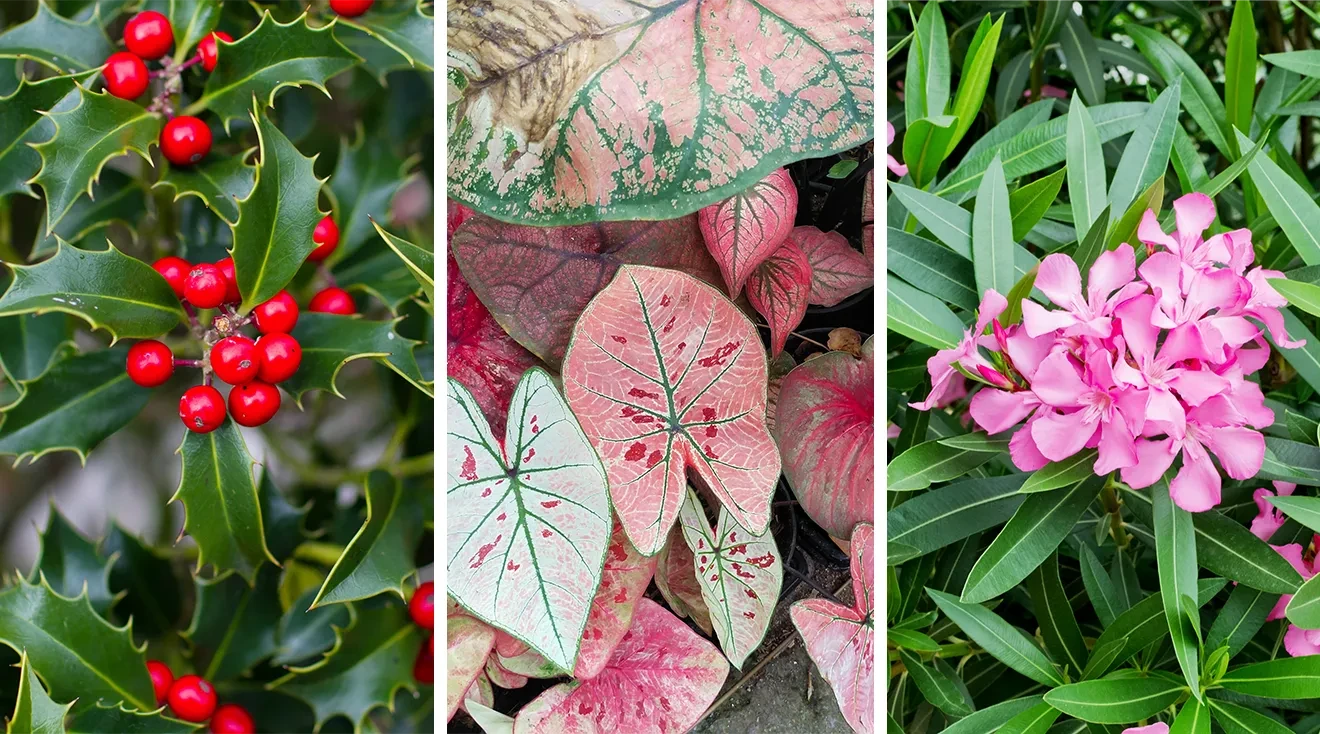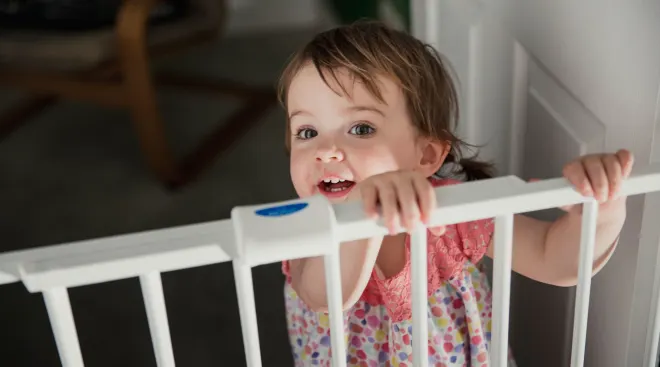15 Plants Found in or Around Your Home That Are Poisonous for Kids
When it comes to babyproofing your house, there are some obvious to-dos: Gate off the stairs, lock the cabinets and cover the outlets. But there’s one thing you might have missed. “We don’t usually think about the plants that live in and around the house and how they can pose a risk to our little ones,” says Katie Friedman, MD, a Florida-based pediatrician and cofounder of Forever Freckled. “It’s important to educate yourself on the different plant species in and around your home and whether they can be poisonous to baby.”
To learn which plants are poisonous, head to your local poison center, suggests Cathleen Clancy, MD, associate medical director of the National Capital Poison Center in Washington, DC. “Bring your plants to the poison center to learn which are poisonous, and also learn their names and teach them to your kids.” Clancy says the best way to childproof your house when it comes to plants is to teach children not to put anything in their mouths that isn’t food. Be sure to place any poisonous plants (as well as low-hanging plants in large pots) out of kids’ reach—or consider only having plants that are safe for children in your home.
The good news is that most houseplants are safe for infants and toddlers. “Even if they put a small piece of a poisonous plant in their mouth, it typically doesn’t taste very good, so a child will usually spit it out and will very rarely go for a second helping,” Friedman says. “Touching or ingesting a poisonous plant may lead to a simple skin reaction or upset stomach. However, there are certain poisonous plants that, if ingested in larger amounts, can result in life-threatening symptoms.” Here’s what you need to know about these common but poisonous plants that may be in or around your home.
While some plants may cause a minor skin rash, others may lead to more serious health concerns and or even be fatal. The University of California’s Agriculture and Natural Resources department classifies four toxicity levels for plants, with level one being the most harmful:
- Level four: Dermatitis. This level contains plants with juice, sap, oil or thorns that could cause an adverse reaction, such as a rash or irritation when exposed to the skin or mucous membranes, IANR notes. You’ll want to wash the affected skin with soap and water immediately after contact.
- Level three: Oxalates. This includes plants that contain calcium oxalate crystals in their juice or sap. These crystals are typically sharp and stab the tongue, throat and gum tissue, the Children’s Hospital of Philadelphia (CHOP) says, likening the sensation to “biting in ground glass.” The oxalates can cause swelling and irritation in the mouth, tongue, throat or skin, which could result in a burning sensation, cause an upset stomach or make it hard to breathe and speak.
- Levels two and one: Major and minor toxicity. These levels include plants that can cause minor bouts of gastrointestinal issues like vomiting and diarrhea, or more serious illnesses. According to the Institute of Agriculture and Natural Resources at the University of Nebraska-Lincoln (IANR), some of this is due to compounds naturally found in plants, including glycosides, which are lethal cardiac toxins that can cause cardiac and gastrointestinal issues; solanine, which can injure the digestive tract and cause abdominal pain, vomiting, diarrhea, weakness and fainting; grayanotoxins, which can cause burning, numbness and tingling in the mouth; and alkaloid lycorine, which can also cause irritation to the gastrointestinal tract. Ingesting some plants in this category can be fatal in certain circumstances.
While these are general guidelines for how toxic a plant can be and what your child’s symptoms may be after exposure, remember that everyone is different. Not everyone’s immune system will react the same way, so it’s imperative to call the poison control hotline (800-222-1222) and your doctor as soon as you learn of any exposure.
Plants that cause skin rashes, hives or itching are perhaps most well-known, thanks to poison ivy. According to CHOP, these plants may cause allergic dermatitis, which is the body’s natural allergic response to toxins, or chemical dermatitis, which is a direct result of of the plant’s chemical toxins on the skin. Allergic dermatitis may take a few days to show up and appear on areas of the body that weren’t exposed. Chemical dermatitis usually occurs within 24 hours and the reaction typically stays in the areas of the skin that were exposed. It can take up to three weeks to resolve both types of dermatitis, and they may be treated with antihistamines and hydrocortisone cream if your child is old enough. Plants like poison ivy likely won’t be found at home but may appear during family time spent outdoors, such as on hikes or in the park.
Poison Ivy, Oak and Sumac
All three of these are wild plants often found in wooded areas. Poison ivy has pointed, green leaves that usually grow around the stem in groups of three—“leaves of three, leave them be,” NCPC notes. It can grow as a vine or a shrub but is most commonly found as vines in the United States. During the spring and fall, poison ivy may grow yellow-green flowers and white berries. Plus, the leaves may change from green to yellow or even red. Poison oak looks similar to poison ivy, but its leaves are rounder rather than pointed, and it grows mostly in shrubs. Poison sumac also grows as pointed leaves, but they grow on both sides of the stem and not in sets of three. Poison sumac is also often found in shrub form.
The dermatitis caused by these plants is due to urushiol, an oil found on their leaves that up to 85 percent of the population is allergic to. The primary symptom (and diagnostic method) is itchy, red rashes that appear 12 to 48 hours after exposure and have a blister-like appearance. The blisters may weep fluid and crust over. According to the American Academy of Dermatology Association, the more often a person is exposed, the more severe their reaction will be. (However, there are also select people who may not get a rash after their first exposure, but may get one after a second exposure.) In terms of contagiousness, you can’t get the rash by touching someone else’s, but you can get it if someone’s skin or clothing still contains traces of urushiol, as well as from pets if they have the oil on their fur. (Most pets aren’t allergic to poison ivy, oak and sumac.)
Toxicity level: 4
While you want to keep your child from ingesting plants with calcium oxalate crystals, poisoning from these plants is rare, CHOP notes. This is because they’re often incredibly painful to eat, which deters small kids from consuming them in large amounts. Below, some common house plants that contain oxalates.
Philodendron
Plenty of families have pots of philodendron scattered around the house, since they’re among the easiest to care for. But beware: When ingested, philodendron can cause pain, difficulty swallowing, swelling of the mouth, tongue or throat, excessive drooling and even loss of speech or issues breathing, notes the National Capital Poison Center (NCPC). Plus, skin exposure can cause rashes, swelling, redness and skin inflammation, while contact of philodendron sap with the eyes may cause eye irritation, corneal abrasions and, in rare cases, permanent eye damage.
Toxicity level: 3
Devil’s Ivy
Devil’s Ivy, also known as pothos, is another highly popular houseplant, with pointed, heart-shaped leaves in white, yellow or pale green. Taking a bite won’t be fatal for your little one, but it can prove to be pretty irritating thanks to its oxalate crystals. If you think your child may have taken a nibble, keep an eye out for possible symptoms, including burning and swelling of the mouth, lips and tongue, as well as difficulty speaking or swallowing.
Toxicity level: 3
Dieffenbachia
Also known as dumb cane or leopard lily, this houseplant’s mix of green, white and yellow leaves makes it stand out. But, like others, because dieffenbachia contains calcium oxalate crystals in its sap, it can cause irritation when exposed to skin or eyes, the NCPC says. Similar to philodendron, dieffenbachia can cause pain, difficulty swallowing, swelling of the mouth, tongue or throat, excessive drooling, loss of speech and respiratory problems.
Toxicity level: 3
Peace Lily
Peace lilies are hardy plants with dark green leaves and white flowers, and are popular among homeowners with less-than-green thumbs. But ingesting them can lead to the same symptoms of irritated skin and mouth, as well as difficulty speaking, breathing and swallowing.
Toxicity level: 3
Caladium
Caladium, also known as elephant ear, has leaves shaped like arrows, hearts or lances, in color combinations of pink, red, white, rose, green and chartreuse. Commonly kept in the home, these poisonous houseplants can irritate the mucus membranes in the mouth, nose, throat and stomach, causing similar symptoms as the rest.
Toxicity level: 3
When ingested, these plants can cause minor gastrointestinal issues, like a bout of vomiting or diarrhea, or cause more serious, even fatal issues. According to the National Capital Poison Center (NCPC), keep an eye on your kids as they play outdoors or near any plants, and always know the names of your plant just in case you do wind up needing to call the poison control hotline.
Oleander
Sometimes planted in gardens around the home, this beautiful flowering shrub is known for its white, pink or yellow blossoms—and for being one of the most poisonous plants around the house. According to IANR, oleander contains glycosides, which, if ingested, can cause nausea, vomiting, a slow heartbeat, low blood pressure, drowsiness and even death. If you suspect your child has eaten oleander, head to the emergency room immediately.
Toxicity level: 1
These trumpet-shaped flowers may seem perfectly innocent, but they can make your little ones sick. Though they’re not very poisonous in small quantities, if your child ingests a large amount, they may suffer from irritation in the mouth and throat as well as nausea, vomiting and diarrhea, CHOP notes.
Toxicity level: 2
Mistletoe
It may be a universal symbol of joy and good cheer, but this holiday favorite is actually on the list of poisonous plants. Eating mistletoe can cause gastroenteritis, an intestinal infection that comes with diarrhea, cramps, nausea, vomiting and fever. It can also lead to a drop in blood pressure, though American mistletoe appears to be less toxic than the European species, the NCPC says.
Toxicity level for European Mistletoe: 1
Toxicity level for American Mistletoe: 2
Holly
If eaten, this common holiday trimming can put a quick end to your family’s merry mood. While the boughs don’t pose a danger, the berries are toxic, and eating even just two can cause vomiting, diarrhea, dehydration and drowsiness, the NCPC cautions. To protect your little ones from these poisonous plants, always remove the berries before decorating your home with fresh holly.
Toxicity level: 2
Azalea
Thanks to their stunning, colorful blooms, azaleas decorate many home lawns and gardens—but they could be fatal for kids. When eaten in very small quantities, your child may get mild symptoms like mouth irritation, nausea and vomiting. But if they swallow larger quantities (like three or more leaves), it can be life threatening, as the plant contains grayanotoxins, the NCPC and CHOP note.
Toxicity level: 1 to 2
Morning Glory
Morning glories are a cheerful flower that adorn many backyards. While the blooms aren’t dangerous for kids, their seeds are—which is why they’re on our list of poisonous plants. The culprit? A chemical similar to LSD, the NCPC explains. If a child eats enough of the seeds, it can lead to a variety of symptoms that require medical attention, from diarrhea to hallucinations. If you have a fresh packet of morning glory seeds from the nursery, keep the kids away until the flowers start to grow.
Toxicity level: 1 to 2
Foxglove
Foxglove is a beautiful bell-shaped flower that grows throughout the US, often cultivated in home gardens. Its white, yellow and pink spring blooms can catch the eye of small children—but they’re actually poisonous plants kids should admire from afar. Foxglove also contains glycosides, CHOP notes and, according to the NCPC, is is often used to make medicine that helps treat heart failure. Due to its cardiac effects, ingesting foxglove can cause the heart rate to become dangerously slow or irregular.
Toxicity level: 1
English Ivy
A fast-growing climber, English ivy is commonly found in people’s homes, on building exteriors and under trees as a ground covering. But if eaten, these poisonous plants can irritate the mouth and cause soreness. In large amounts, it can cause severe swelling farther down the throat.
Toxicity level: 2
If you suspect your child has had skin contact with or ingested a poisonous plant, assess the situation. If they’re experiencing any difficulty breathing, shortness of breath or swelling of the mouth or throat, take them to the ER or call 911, as they could be suffering from a life-threatening emergency, CHOP says. For situations that are less severe, there are a number of things parents can do to help their child.
Call the poison control hotline
The poison control hotline can be reached at 800-222-1222 and they can offer guidance on what to do if your child has been exposed to a poisonous plant. The staff may not always be able to identify the plant over the phone, but they can advise you on what to do next, based on your child’s symptoms and what the plant looks like. (It’s always helpful to give them a name for the plant, if you know it.)
Call your doctor
If you’re concerned about your child’s health in any way, or if they develop a skin reaction or an upset stomach, call their pediatrician. They may want to evaluate your little one in the office or be able to offer a treatment plan over the phone. Either way, it’s important to give them a ring and let them know what’s going on, even if the situation doesn’t seem bad at the moment—especially since some effects of poisonous plants may not crop up right away.
Wipe away the residue
If your child has eaten a plant with oxalates, wipe the plant residue from your child’s mouth, CHOP suggests. Offering them a cool drink or snack, like milk, a popsicle, applesauce or yogurt may also help with any mild mouth pain and discomfort.
Wash exposed skin
If your child has come into contact with a poisonous plant, to get ahead of any dermatitis, wash your child’s affected skin areas thoroughly with soap and water immediately. You should also wash their clothes, shoes and anything else that may have come into contact with the plant, its sap or oils. It’s also a good idea to flush out your kiddo’s eyes with lukewarm water for 10 to 15 minutes, and wash their hands thoroughly with water and soap.
Use a cool compress or cream
To help with any itching from dermatitis, try a cool compress, or—with your pediatrician’s approval—hydrocortisone cream. Oral antihistamines, like Benadryl, can be used if the itching is really driving your child crazy (and they’re old enough), says Alanna Levine, MD, a pediatrician at Orangetown Pediatric Associates in Orangeburg, New York. If the rash seems to be getting worse or is associated with significant swelling, fever or difficulty breathing, it’s time to see a doctor. “Also, if there is involvement of the face, especially swelling of the eyes, see your doctor. This may require an oral steroid medication,” Levine says.
Ensure they stay hydrated
If your child is vomiting or has diarrhea, it’s important to ensure they’re staying hydrated with electrolyte solution such as Pedialyte.
Go with your gut
No parent ever wants to think about accidental poisoning when it comes to their little ones, but it’s important to be aware of the seemingly innocent house and garden plants that may pose a real threat. Educate both yourself and your child about them and teach them to stay away from these plants while playing. And if an accident does occur, don’t hesitate to call for help. Even with these guidelines, poisonous plants can affect each person differently. It’s best to be safe and get the guidance you need to ensure your child’s health and safety.
Please note: The Bump and the materials and information it contains are not intended to, and do not constitute, medical or other health advice or diagnosis and should not be used as such. You should always consult with a qualified physician or health professional about your specific circumstances.
Cathleen Clancy, MD, is an associate professor of emergency medicine at the George Washington University School of Medicine and Health Sciences, as well as the associate medical director for the National Capital Poison Center. Clancy completed her medical degree at Case Western Reserve University School of Medicine, as well as postdoctoral training at Yale New Haven Hospital and medical toxicology training at the National Capital Poison Center.
Katie Friedman, MD, is a Florida-based pediatrician and cofounder of the blog Forever Freckled. She specializes in pediatric emergencies and received her medical degree from Rosalind Franklin University of Medicine and Science in Illinois. She completed her residency at Jackson Memorial Hospital in Florida.
Alanna Levine, MD, is a pediatrician and managing partner at Orangetown Pediatric Associates in Orangeburg, New York, as well as a spokesperson for the American Academy of Pediatrics. She received her medical degree from Sackler School of Medicine and completed her residency at Mount Sinai School of Medicine in New York City.
Learn how we ensure the accuracy of our content through our editorial and medical review process.
Navigate forward to interact with the calendar and select a date. Press the question mark key to get the keyboard shortcuts for changing dates.


































































